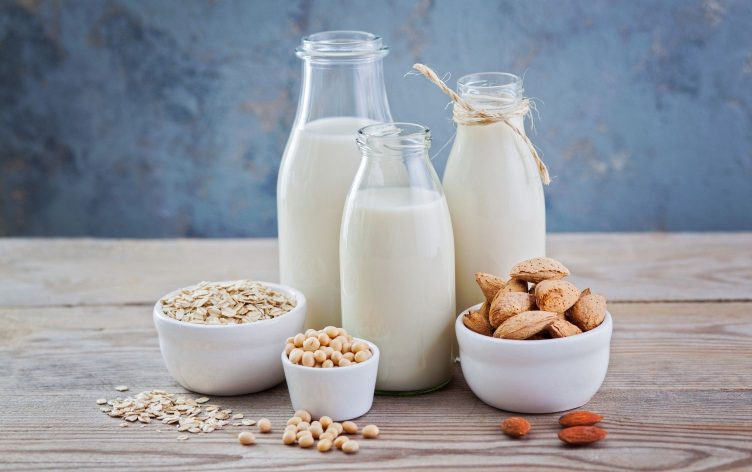
Is Plant-Based Dairy Better for You Than the Real Deal?
Head over to the dairy case these days and you may notice that there are just as many plant-based yogurts, cheeses, milks, creamers and butters as there are the traditional cow’s milk varieties. And they’re certainly growing in popularity: Growth in plant-based dairy alternatives has increased by 55 percent over the last two years, according to the Good Food Institute. Combined, they’re worth $1.9 billion dollars. But is it really better for you to ditch the moo?
First, let’s dig into what these are made of. The ingredients subbed into nondairy alternatives depend on what product you’re buying. For instance, nondairy yogurt might use almond, coconut or oat milk as the base, various gums (such as xanthan gum) to get the right texture, then add fruit puree and probiotics. A nondairy cheese may use various oils — coconut, canola, safflower — plus flour (tapioca, konjac), xanthan gum, colors and nutritional yeast for that cheese-like bite. Plant-based butters are mostly made of a blend of vegetable oils, plus other ingredients for the right color and texture.
Certainly, there are several reasons you might turn to plant-based dairy: lactose intolerance, milk allergy, disliking the taste of dairy, following a vegan lifestyle or ethical concerns, says Amy Kimberlain, RDN, a spokesperson for the Academy of Nutrition and Dietetics. It’s also trendy to give up dairy for health reasons, too.
While the reason to consume cow’s milk dairy or go for plant-based options is a personal one, know that they’re not a nutritionally identical swap. Most of the time that’s not a problem (you can make up for the difference with foods you eat at other times per day), but it’s important to be aware of it so you can make those adjustments.
For example, compare cow’s milk with nondairy alternatives. “The biggest distinction, most times, is the protein, calcium and vitamin D,” says Kimberlain. You’ll find about 8 grams of protein per cup of cow’s milk, but just 1 gram of protein in almond or rice milk and no protein in coconut milk, she points out. Soy milk is the most comparable to cow’s milk with 7 grams of protein. In addition, not all milk alternatives are fortified with calcium and vitamin D, a duo that’s important for bone health. If you used to eat dairy yogurt, for instance, and you switched to a non-fortified plant yogurt, you’ll need to make sure to get calcium and vitamin D elsewhere in your diet, such as through dark green leafy vegetables (calcium) or UV-exposed mushrooms (vitamin D) or fortified orange juice (for both nutrients).
Another example is cheese. Part-skim shredded mozzarella has 65 calories, 5 grams of protein, 4 grams of fat, and about 2 grams of carbs. A plant-based shredded mozzarella, on the other hand, has 80 calories, 0 grams of protein, 5 grams of fat, and 8 grams of carbohydrates. Both count as good sources of calcium. As you can see, the biggest difference is that the dairy-free version does not supply protein. If you’re making a dairy-free cheese and veggie pizza, each slice contains less protein than a traditional one, and that can affect how filling your meal is.
Overall, check the brand you’re going to buy and compare labels to see how yours stacks up, suggests Kimberlain. In addition, read the ingredients to know what you’re getting. “Some will include added oils, sugar, salt and additives,” she says. Many of these are packed with added sugar to improve taste. Many dairy versions are rich in sugar, too, so it’s a matter of comparing labels and buying one that aligns with your goals.
TO DAIRY OR NOT TO DAIRY
What if you still enjoy dairy and your body can tolerate lactose just fine — will giving it up in favor of plant-based dairy make you healthier? Not necessarily. There may be no reason to fear dairy (or eat alternatives if you prefer cow’s milk versions). One meta-analysis of three cohort studies totaling more than 217,000 participants concluded that consuming 2 servings of dairy per day was associated with the lowest mortality and death from cardiovascular disease, per BMJ in 2019. However, the authors found replacing dairy with nuts, legumes or whole grains could lower the risk of death. They did not, however, analyze what happens if one substitutes with plant-based dairy products rather than these whole foods. (It’s also important to know that eating an almond milk yogurt, for instance, isn’t the same as eating almonds, Kimberlain points out.)
A more recent umbrella review of 41 meta-analyses in 2021 in Nutrition & Metabolism found consuming about 1 cup of milk per day was linked to a lower risk of heart disease, stroke, hypertension, colorectal cancer, metabolic syndrome, obesity and osteoporosis. The downside? This study also found a higher risk of prostate cancer, as well as Parkinson’s disease and acne. Whether or not you switch in the name of health depends on your personal health history, and is a discussion to have with your healthcare professional.
THE BOTTOM LINE
Whether or not you choose plant-based dairy over cow’s milk dairy is a personal one driven by a variety of factors, including taste preferences, ethical concerns or lactose intolerance. If you make the switch, carefully scan the nutrition and ingredients label and compare protein, calcium, vitamin D and sugar content between brands, choosing the one that makes the most sense for your diet.





